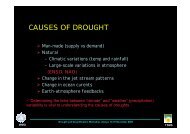Slayt 1 - RTC, Regional Training Centre - Turkey
Slayt 1 - RTC, Regional Training Centre - Turkey
Slayt 1 - RTC, Regional Training Centre - Turkey
Create successful ePaper yourself
Turn your PDF publications into a flip-book with our unique Google optimized e-Paper software.
Model ComponentsCentralized Guidance:Using all of the forecasting tools at their disposal, NCEP meteorologists produce subjective, centralized guidanceproducts, such as hurricane track predictions, severe weather outlooks and discussions, and quantitative precipitationforecasts. These products are added to the mix of tools and resources used by forecasters.Numerical Guidance:Numerical guidance products are produced through postprocessing of the model output. They are in a form that can bereadily used by forecasters and are usually displayed on a grid with a different resolution than the original model.Examples include geopotential height charts, MSL pressure, and surface temperature. Aircraft turbulence and icingcharts are examples of fields calculated from numerical model output using physically based empirical relationships.Statistical Guidance:Some sensible weather elements, such as visibility and thunderstorms, are not predicted by the model and cannot bederived directly from the model forecast variables. Other parameters, such as surface maximum temperature, aresensitive to model weaknesses and vary locally. Statistical techniques, such as Model Output Statistics (MOS), have beendeveloped to predict weather elements at particular point locations from direct and postprocessed model fields andother pertinent data, including climatology.Direct Model Output:Direct model output typically refers to gridded forecast data provided at each model grid point and vertical level. Thesedata are not interpolated for locations between model gridpoints and levels. The output data are used by forecasters todevelop a wide variety of local forecast and diagnostic products and provide a look inside the model.Model Output:Model output products include all products that use model fields. The model forecast variables can be looked at directly,postprocessed into grids, plots, station predictions, etc., and used in combination with climatology and other datasources in statistical forecasts. Collectively, they are an important part of the forecast process.Postprocessing:In postprocessing, computations are made to the raw model output to transform it to a format readily usable byforecasters. Diagnostics and meteorological parameters are derived from the forecast variables. In addition, modelvariables are interpolated vertically to surfaces used by forecasters (isobaric, isentropic, and constant altitude) andinterpolated horizontally to forecast locations or output grids. Contour plots are also made. Additional postprocessing,such as using AWIPS algorithms, may be done later. The resulting products are collectively referred to as "numericalguidance."Physics:In NWP, physical processes refer to three types of processes:Those operating on scales smaller than the model resolution but which exert a cumulative effect felt at resolvable scalesThose involving exchanges of energy, water, and momentum between the atmosphere and external sources (forexample, radiation and land and sea surface processes)Cloud and precipitation microphysics
















